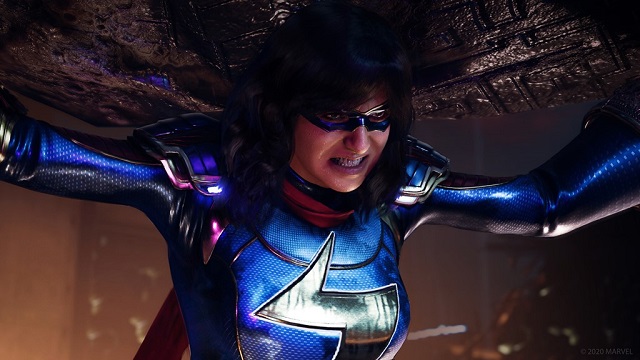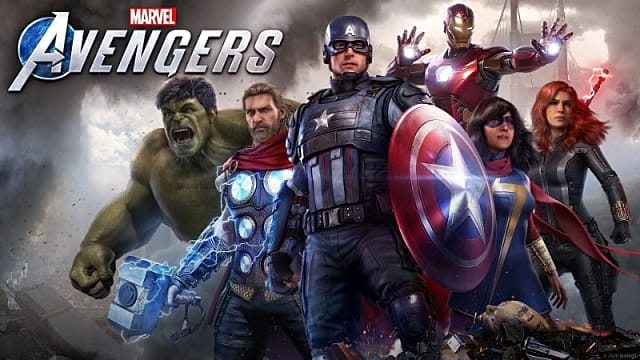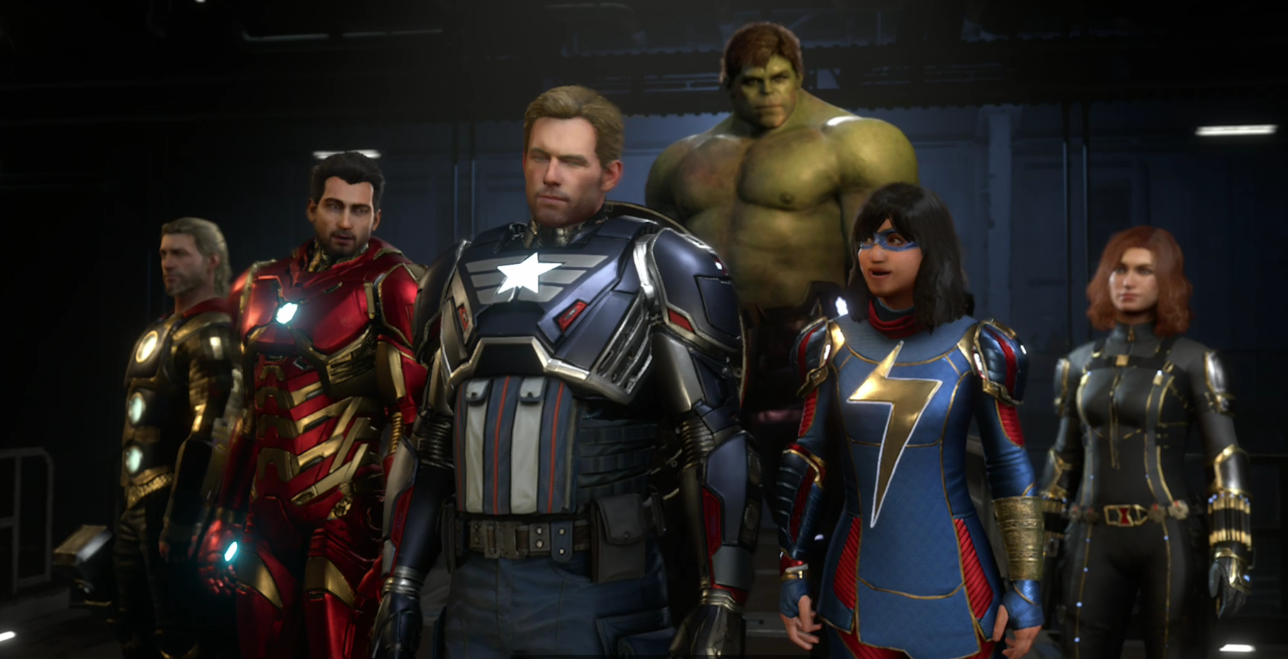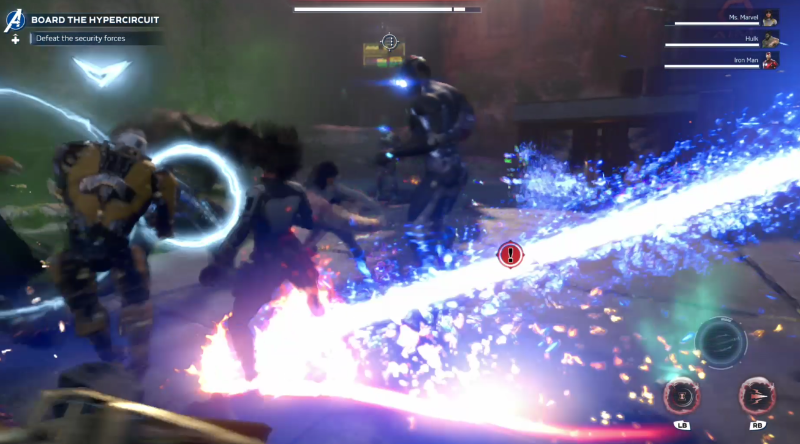As they’re known to do when defending the world from the latest existential threats, the titular superheroes of Marvel’s Avengers will regularly quip during combat.
Cliched phrases like “We’ve got company!” are mouthed often, and Tony Stark has enough one-liners up his metallic sleeves to last an extended MCU marathon. Sometimes, Black Widow offers a one-liner that’s been stuck in my mind for days: “This should be fun!”
It’s meant to reflect both her innate heroism and penchant for a bit of chaos, as if she can’t wait to dive into the action ahead of her. But I never heard it that way.
In my head, it was more like “this should be fun.” And I thought of it in regards to the game itself. Marvel’s Avengers should be fun. Remarkably, it rarely ever is.
Marvel’s Avengers Review: Earth’s Mightiest Heroes Fall
Marvel’s Avengers is a mess. The back-of-the-box allure of a four-player co-op game with an ever-expanding roster of heroes vanishes long before its 10-hour campaign comes to an end.
The game’s overarching design is driven by conflicting goals where a more traditional superhero game and a long-tailed loot-brawler clash early and often, and they never actually mesh well by the end of the story or during Avengers’ endgame.
It’s apparent that the loot-chasing parts of Avengers were more of a mandate than an inspiration. Avengers certainly did not need to be Destiny with superheroes, and while I do think such a game can be made well, this isn’t it.
In trying to be like Destiny, Avengers comes off much more like Anthem. There’s a ton of gear with nowhere to use it. It feels like the vast majority of would-be fans would much prefer it wasn’t tied down with gear scores and number-crunching. And for the folks that do like that stuff, Avengers isn’t good at delivering it anyway.
Gear bonuses are often inconsequential, only giving you slight advantages after several prerequisites are met. I feel for the average gamer who sees a new Avengers game and buys it not knowing they have just been assigned math homework. Thankfully, there’s an “Equip Best Gear” button that should keep players out of that screen for too long if they’re not interested in it.
Visually, the game is hampered by regular frame rate drops and a strange camera-shake setting enabled by default, even as the game looks and plays better when it’s turned off. The menus are dominated by an ugly greyish color, while the interiors of levels are almost exclusively set in repetitive and drab science labs housed by the villain’s robot army.
Mission variety in Avengers regularly annoys as missions come in three main types:
- Linear story missions, which flash signs of life in the otherwise bloated world
- Drop zones, which are brief and highly repetitive missions that have players arrive at a location and perform some sort of rote task, like defeating X enemies or controlling an area until a meter fills up
- Threat sectors, a final mission type that is somehow even worse than the other two
Across a low number of large hub levels, players will sprint to icons, defeat a few tragically boring robots, and collect some sort of gear, like a chest plate or gauntlets, with the hopes of incrementally improving their characters’ gear scores toward an end goal that never actually manifests.
These mile-wide missions are forever an inch deep, and it’s remarkable to see how poorly the open space is used. Dropping players into one corner of the map only to put all of their objectives or points of interest hundreds of meters away begs the question: “Why was the space so vast to begin with?”
It demands every mission begins with running toward a marker in a land of nothingness. These missions are clearly inspired by the likes of Destiny or The Division, but unlike those games, Marvel’s Avengers never manages to create a memorable moment in any level because none are efficiently paced.
The cast of heroes is the game’s best attribute at its rocky launch, as Ms. Marvel joins a squad of familiars in Thor, Iron Man, Black Widow, Hulk, and Captain America.
Ms. Marvel’s early-campaign focus brings a unique look to the game’s story after we’ve already seen these other heroes so much over the last decade, but her faithfully-recreated fangirling fails for similar reasons. As the stand-in for the player, Ms. Marvel’s fascination with Earth’s Mightiest Heroes doesn’t translate.
In her world, The Avengers are still stunning. But in our world, we’ve seen them perform feats of heroism for over 10 years in the movies, and much longer for comic fans. The allure of the Avengers must come from playing as them, not just being in their vicinity, but playing as them is hardly more interesting.
At least the star-studded cast does well to bring the characters to life, even as some are familiar, like Nolan North playing Iron Man as Nathan Drake in armor. Troy Baker performing a more reserved, unsure Bruce Banner is the brightest spot on the billing, but there are no bad performances in the game.
The tallest task Crystal Dynamics and the bundle of supporting studios had for this game was always going to involve the combat, as each hero needs to play differently from the others, and superficially, Avengers gets that right.
Hulk’s power and Black Widow’s agility are as vastly different in appearance as they need to be, but the gear-chasing of the game still hampers this area by creating something close to parity among characters who are otherwise equally leveled.
In what world do the Incredible Hulk and Black Widow pack the same punch? Only in this one, as evidenced by the way the game’s endless stream of nameless enemies can absorb equal blows from either hero should their stats be similar.
The game’s HUD is the opposite of immersive, with so many meters, signals, QTEs, and icons to crowd your screen that it’s genuinely difficult to appreciate the game’s combat at times, particularly when you and your partners are cramped together and the game feels ready to explode your TV or monitor with its mess of colors and effects.
Punching robots repeatedly wouldn’t be that great alone, but it’s even worse when the game is so busy like this.
And those robots also represent one of the game’s most glaring issues: a wildly lacking cast of villains. After an opening fight with Taskmaster that serves as a tutorial, virtually ever mission pits your heroes against a horde of robots.
While within this race of automated killers there is a great number of enemy types, the fact that players can spend dozens of hours in a Marvel game and almost never take on familiar supervillains from the comics stands in stark antithesis to the game’s marketing, which promised a “celebration” of 80 years of Marvel.
Truthfully, the only way in which this game celebrates the brand’s long history is through its cosmetics store, which right off the bat offers a massive range of new costumes for every hero in the game, each of them at insulting prices for a fully-priced game.
Some AAA games have taken their suggested transactional cues from Fortnite and Warzone but those games are free to start. Avengers is $60 minimum at launch, but packs so much paid content into its store right away that it feels like a slap in the face from the Hulk himself.
The endgame that follows the relatively brief campaign is where players are meant to live out their long-term metahuman fantasies, but Avengers doesn’t give any reason to do that yet. You can keep leveling your gear and chase higher ranking missions, but they rarely evolve into anything interesting or new. Instead, more of the same robot punching is on display for as long as you’re willing to keep it on your screen.
After the credits, I had 20+ missions available to play, but as I played them, I found they merely offered more of what I had just dragged my feet through. It feels like players are meant to prepare for this game’s Taken King moment by leveling up now, but there’s no guarantee this game’s first big expansion will even salvage it.
If boring missions, predatory cosmetics, and a lackluster story weren’t enough to bury Avengers, its astounding lack of polish is the final nail in its coffin.
I honestly regret not taking notes, because in my time with Avengers, I saw more bugs than I can even remember. But the ones I do recall range from slightly annoying visual glitches, like characters missing hair in scenes to more problematic stuff like maps and UI simply disappearing when I needed them. There was even a fully game-breaking bug that halted my progress for days.
In the lattermost case, a particular enemy spawn on the game’s final mission would unavoidably crash my game every single time. This led to me not getting to the credits or seeing its post-game content for a few days during my review period with the game. Then one day, it miraculously began working again, so I was mercifully able to get to the endgame.
In a game that was pushed from April to September, it’s clear Avengers needed even more dev time. It’s in a sad state at launch, the worst I’ve seen of any major game release in a long time.
In a post-Arkham world, Marvel’s Avengers might’ve had a tough time raising the bar, but at least the groundwork had been laid by the likes of Batman and Spider-Man. By chasing the potential of figurative whales in the game’s cosmetics shop, Avengers ignores a pretty obvious blueprint in favor of something that suffers from bugs and feature-creep in equal measure.
It’s a game that never feels cohesive and only occasionally even feels fun to play.
Marvel’s Avengers Review — The Bottom Line

Pros
- Heroes stand out from each other somewhat well in combat
- Voice acting is very good across the board
Cons
- Bugs everywhere, including game-breaking gltiches
- Cosmetics shop is priced like a free-to-play game
- Missions are formulaic, repetitive, and misused
- Wildly lacking in familiar villains
- Crowded HUD data leaves combat a mess
- An endgame that serves no purpose
- Feels like two disparate games in one, with neither shining as a result
I foresaw a rough start to this game, but I remained excited nonetheless. I believed, like with many similar games, we’d get a game worthy of the Avengers name. But the bright spots in Avengers are so few and far between that I don’t know how the team could even save this game.
The worst part is that it brings me no joy to say any of this.
I wanted to like this game, as the basic premise — co-op Avengers — seemed destined for greatness. At least eventually, if not right away. Sadly, the end result is a rushed, broken, disassembled experience that never delivers on that once-thought unbeatable premise, leaving me feeling more despondent than Tony Stark after The Snap.
Maybe the heroes can save the day in the future, but right now, they look defeated.
[Note: Square Enix provided the copy of Marvel’s Avengers used for the review.]









Published: Sep 8, 2020 03:18 pm